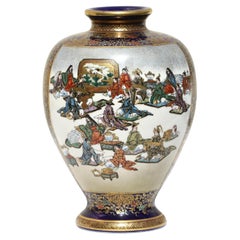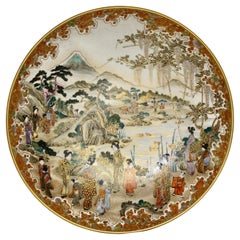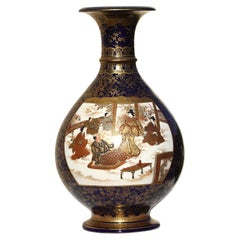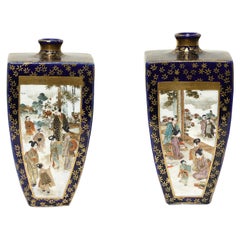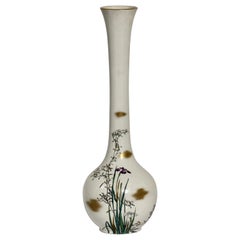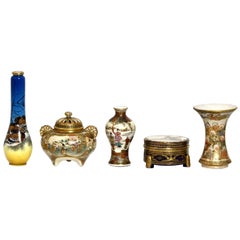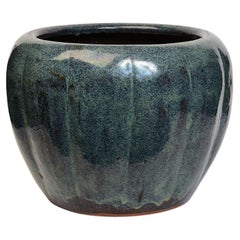Kinkozan Furniture
to
6
6
1
5
1
1
5
1
1
6
6
6
10
55
22
21
20
Creator: Kinkozan
Dealer: A.B. Levy's
Japanese Kinkozan Gilt and Enameled Blue-Ground Vase, Meiji Period
By Kinkozan
Located in West Palm Beach, FL
Japanese Kinkozan Gilt and Enameled Blue-Ground Vase, Meiji Period (circa 1900), GILT MARK WITHIN A SQUARE, of compressed baluster form with short everted neck, decorated with rectan...
Category
Early 1900s Antique Kinkozan Furniture
Materials
Enamel
An Earthenware Dish By Kinkozan, Meiji period, late 19th century
By Kinkozan
Located in West Palm Beach, FL
An earthenware dish
By Kinkozan, Meiji period, late 19th century
Painted in polychrome enamels and gilt over a clear crackled glaze with beauties and children enjoying a summer outing in a mountainous water landscape, the scene surrounded by a frame of blossoming flower heads,
signed in gilt Kinkozan zo...
Category
19th Century Antique Kinkozan Furniture
Materials
Ceramic
Japanese Satsuma Earthenware Vase by Kinkozan, Meiji Period
By Kinkozan
Located in West Palm Beach, FL
A Japanese Satsuma Earthenware Vase by Kinkozan, Meiji period (1868-1912)
The body inset with two panels, one depicting figures seated around a table, the other painted with a joyful scene in a shrine, all reserved on a blue ground decorated with a gilt flower pattern, signed Nihon Kyoto Kinkozan zo...
Category
20th Century Kinkozan Furniture
Materials
Ceramic
A Pair Satsuma earthenware vases by Kinkozan, Meiji period
By Kinkozan
Located in West Palm Beach, FL
A Pair Satsuma earthenware vases by Kinkozan, Meiji period
of square section, decorated with birds and flowers alternating with figures, all reserved on a midnight-blue ground with floral designs, each signed Kinkozan zo...
Category
20th Century Kinkozan Furniture
Materials
Ceramic
Kinkozan, Japanese Satsuma Vase, Meiji Period
By Kinkozan
Located in West Palm Beach, FL
Kinkozan, Japanese Satsuma vase,
Meiji Period (1868-1912)
Of baluster form with an elongated neck decorated in polychrome enamels and gilt on a clear crackle glaze in an Art-Nouvea...
Category
20th Century Kinkozan Furniture
Materials
Ceramic
Collection of Five Signed Antique Satsuma Miniatures
By Kinkozan
Located in West Palm Beach, FL
A collection of five signed antique Satsuma miniatures,
each an example of the variant Satsuma studios;
from the graduated color of
Tozan, to the gi...
Category
20th Century Kinkozan Furniture
Materials
Ceramic
Related Items
Japanese Meiji Period (1868-1912) Satsuma Earthenware Vase Taizan for Hattori
Located in Newark, England
Meiji Period (1868-1912)
From our Japanese collection, we are delighted to offer Japanese Meiji Period Satsuma Vases. The Satsuma Vase of hexagonal form with a slight waisted neck and tight rounded rim is extensively decorated with multiple figures to two large scenes. The first scene features a beach with waves to the background and a plethora of figures including multiple geisha holding traditional Japanese wagasa’s. The second scene follows on from the first with a large building in the foreground holding figures on a large platform under a pagoda roof with a pagoda building in the background and further figures in the foreground. The scenes are framed by a full detailed border with gilt shapes, flowers amongst pink shaded backgrounds and butterflies around the neck. The Satsuma Vase is unusually signed Fine Art, Satsuma Ware, Dai Nippon (Great Japan), Hattori Made, Gosuido Works, Taizan Painted. 美術, サツマヤキ(薩摩焼), 大日本, 服部造, 五スイ堂工, 對山画 and dates to the Meiji Period (1868-1912) and the turn of the 20th century circa 1905.
Satsuma ware is a type of earthenware pottery originating from the Satsuma province in Southern Kyushu, Japan’s third largest island.
Wagasa are traditional Japanese umbrellas made of washi paper attached to a bamboo frame and treated to ensure it is waterproof.
Meiji Period was an era of Japanese history that spanned from 1868 to 1912. It was the first half of the Empire of Japan, when the Japanese people began to build a paradigm of a modern, industrialised nation state and emergent great power, influenced by Western countries and aesthetics. As a result of radically different ideas, the changes to Japan were profound and it affected the social structure, politics, economy, military, and foreign relations across the board. The period corresponded to the reign of Emperor Meiji and was preceded by the Keio era and was succeeded by the Taisho era.
Cultural Art during the Meiji Period was of particular interest to the government and they overhauled the art export market which in turn promoted Japanese arts via various world’s fairs, beginning in Vienna at the world fair in 1873. The government heavily funded the fairs and took an active role organising how Japan’s culture was presented to the world including creating a semi-public company named Kiritsu Kosho Kaisha (First Industrial Manufacturing Company). The Kiritsu Kosho Kaisha was used to promote and commercialise exports of Japanese art and established the Hakurankai Jimukyoku (Exhibition Bureau) to maintain quality standards. For the 1876 Centennial International Exhibition in Philadelphia, the Japanese government created a Centennial Office and sent a special envoy to secure space for the 30,000 items that would be displayed. The Imperial Household also took an active interest in arts and crafts, commissioning works by select artists to be given as gifts for foreign dignitaries further emphasising the high quality and importance of Japanese art. Just before the end of the 19th century in 1890, the Teishitsu Gigeiin (Artist to the Imperial Household) system was created to recognise distinguished artists. These artists were selected for their exceptionally high quality wares and talent in their own industry. Over a period of 54 years Seventy artists were appointed, amongst these were ceramicist Makuzu Kozan and cloisonné enamel artist...
Category
Early 1900s Japanese Meiji Antique Kinkozan Furniture
Materials
Earthenware, Pottery
H 4.63 in W 2.17 in D 2.37 in
19th Century, Meiji, Antique Japanese Ceramic Jar
Located in Sampantawong, TH
Antique Japanese ceramic jar.
Age: Japan, Meiji Period, 19th century
Size: Height 34 C.M. / Width 46.2 C.M.
Condition: Nice condition overall.
100% satisfaction and authenticity guaranteed...
Category
19th Century Japanese Antique Kinkozan Furniture
Materials
Ceramic
Antique Meiji Period Japanese Satsuma Vase Floral Decoration, 19th Century
Located in Amsterdam, Noord Holland
Fabulous Japanese earthenware Satsuma Vase with nice decoration of flowers. Meiji period, 19/20th c
Lovely piece.
Additional information:
Material: Porcelain & Pottery
Japanese Sty...
Category
19th Century Japanese Meiji Antique Kinkozan Furniture
Materials
Porcelain
A Very Fine Japanese Satsuma Cylinder Vase, Meiji Period (1868-1912)
By Kinkozan
Located in Ottawa, Ontario
The flaring cylindrical stoneware body richly decorated with hand painted enamels depicting songbirds perched upon flowering Sakura branches (cherry trees) set against a progressivel...
Category
Early 20th Century Japanese Meiji Kinkozan Furniture
Materials
Enamel
19th Century, Meiji, Antique Japanese Wooden Noh Mask
Located in Sampantawong, TH
Antique Japanese wooden Noh mask.
Age: Japan, Meiji Period, 19th Century
Size: Length 20 C.M. / Width 13.9 C.M. / Thickness 8 C.M.
Condition: Nice condition overall (some expected d...
Category
19th Century Japanese Antique Kinkozan Furniture
Materials
Wood
19th Century 3 Pieces Japanese Porcelain Dishes Meiji Period
Located in Brea, CA
19th century 3 pieces Japanese porcelain dishes Meiji period decorated, largest 15.25'' x 2'', medium 13.25'' x 2'', smallest 12'' x 1.5''.
Category
Late 19th Century Japanese Japonisme Antique Kinkozan Furniture
Materials
Porcelain
Japanese Meiji Period (1868-1912) Satsuma Vase by Kinkozan
By Kinkozan
Located in Newark, England
JAPANESE SATSUMA PROCESSIONAL VASE
From our Japanese collection, we are delighted to introduce to the market this Japanese Satsuma Vase by Kinkozan. The vase with a compressed body ...
Category
Late 19th Century Japanese Meiji Antique Kinkozan Furniture
Materials
Ceramic, Earthenware, Pottery
Japanese Satsuma Dragon Vase, Meiji Period, c 1900, Japan
By Satsuma
Located in Austin, TX
A fantastic small Japanese Satsuma vase with image of writhing dragons, Meiji Period, circa 1900, Japan.
The vase of elegant baluster form, with a slightly flared foot, slender body...
Category
Early 1900s Japanese Meiji Antique Kinkozan Furniture
Materials
Ceramic, Porcelain, Pottery, Stoneware, Hardwood
Antique Japanese Satsuma Miniature Cabinet Vase
By Master Ryozan
Located in Philadelphia, PA
A fine diminutive, antique Japanese Satsuma pottery cabinet vase.
Decorated throughout with gilding and raised enamel.
There are...
Category
20th Century Japanese Meiji Kinkozan Furniture
Materials
Ceramic
Unusual Pair of Japanese Meiji Period (1868-1912) Satsuma Vases by Kinkozan
By Kinkozan
Located in Newark, England
Taizan Yohei IX Style
From our Japanese collection we are delighted to offer this pair of Japanese Satsuma Vases by Kinkozan. The Satsuma Vases of baluster shape made from earthenwa...
Category
Early 1900s Japanese Meiji Antique Kinkozan Furniture
Materials
Ceramic, Earthenware, Pottery
Japan Satsuma Porcelain Vase and Golden Metal 19th Century
Located in Beuzevillette, FR
Large Satsuma porcelain vase from the Meiji on a gilt metal frame from the Napoleon III period. On one side of the vase is represented a deity, probably ...
Category
19th Century Meiji Antique Kinkozan Furniture
Materials
Metal
Meiji Period Diminutive Satsuma Baluster Vase.
By Satsuma
Located in Vero Beach, FL
Meiji Period Diminutive Satsuma Baluster Vase.
This Japanese Satsuma vase from the late Meiji period is hand painted and gilt decorated with a Japanese landscape in exquisite detail...
Category
20th Century Japanese Meiji Kinkozan Furniture
Materials
Porcelain
Kinkozan furniture for sale on 1stDibs.
Kinkozan furniture are available for sale on 1stDibs. These distinctive items are frequently made of ceramic and are designed with extraordinary care. There are many options to choose from in our collection of Kinkozan furniture, although brown editions of this piece are particularly popular. If you’re looking for additional options, many customers also consider furniture by Imari Porcelain, Makuzu Kozan, and Ando Jubei. Prices for Kinkozan furniture can differ depending upon size, time period and other attributes — on 1stDibs, these items begin at $695 and can go as high as $22,122, while a piece like these, on average, fetch $4,650.
Creators Similar to Kinkozan
Questions About Kinkozan Furniture
- 1stDibs ExpertApril 5, 2022Satsuma porcelain or pottery includes a maker’s mark with the name of the person who made the item. Japanese numbers may also indicate that a Satsuma piece was part of a collection. Genuine Satsuma pieces will not have a “Made in Japan” label and should only include Japanese characters. When in doubt, work with a certified appraiser to determine the authenticity of your Satsuma piece. Find a variety of expertly vetted Satsuma porcelain and pottery collectibles on 1stDibs.
- 1stDibs ExpertNovember 4, 2024To identify Satsuma pottery marks, you'll typically need to perform research using trusted online resources. Satsuma is a region in Japan known for its pottery, and many factories and artisans have operated there, including Kinkozan, Taizan, Yasuda, Choshuzan, Fuzan, Gyozan, Koshida and Maruni Kobe. Each maker has its own marks associated with it, and these typically are in Japanese kanji characters. You can compare the characters on your piece to pictures shared online to find a match. Alternatively, a certified appraiser or experienced antique dealer can help you identify your pottery markings. On 1stDibs, shop a selection of Satsuma pottery.
